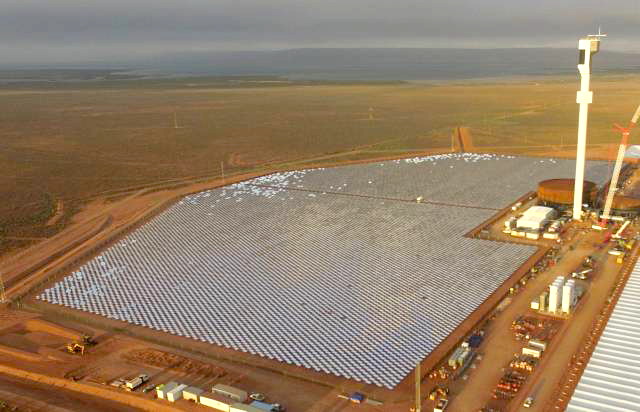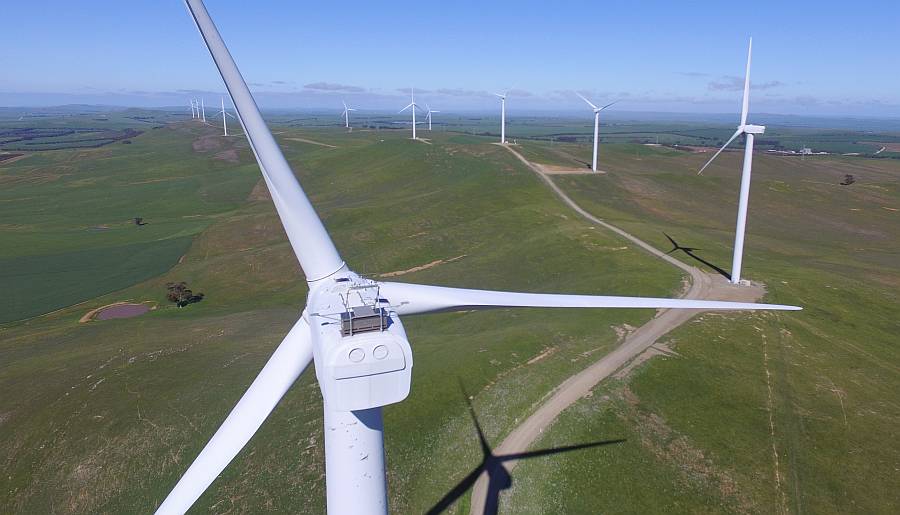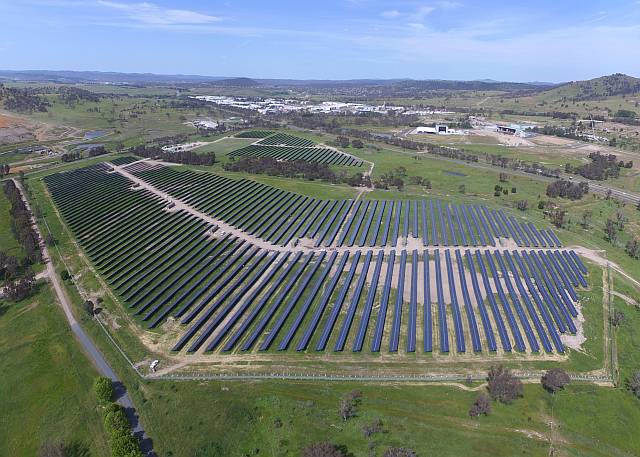| |
The solar power installation of Sundrop Farms
|
|---|

| |
Sundrop Farm is a huge greenhouse development near Port Augusta in South Australia, powered by solar including the desalination of the water required.
Photo taken by my drone, 2016/03/14
| |
French company Neoen is intending to build the
Crystal Brook Energy Park (CBEP) in northern South Australia.
The CBEP will include a wind farm, solar farm, big battery and an electrolytic hydrogen plant aimed at producing 20 tonnes of hydrogen per day.
Garth Heron of Neoen has said:
"At CB we are aiming to be competitive with Australian based steam methane reformation economics for hydrogen production."
I believe that most Australian steam methane reformation would use natural gas; that is, mainly methane.
There is another renewably powered electrolytic hydrogen production plant planned for
Port Lincoln, also in South Australia.
It has been reported that the Port Lincoln facility will produce ten tonnes of hydrogen per day.
It is worth noting that photo-voltaic solar with electrolytic hydrogen production could compete with solar thermal power with storage.
| |
This section added
2021/04/28
|
|
I've been trying to find out what will be done with the oxygen when renewable energy is used to break water down into hydrogen and oxygen. I would think that the oxygen would be collected and sold, but curiously I've not been able to confirm this. Surely selling the oxygen would make the hydrogen production system more economically viable?
Water is made up of oxygen and hydrogen. Every 9kg of water contains 1kg of hydrogen and 8kg of oxygen.
According to Pharmacompass the average price of oxygen is US$12/kg, but they quote prices from $2 up to $27. The current cost of hydrogen is around US$2/kg (that is hydrogen made from fossil fuels, green hydrogen is more expensive).
Even if we accept the lowest price of $2/kg for oxygen we can easily calculate that 9kg of water would give $16 worth of oxygen and $2 worth of hydrogen.
The implication is that collecting and selling the oxygen would be far more profitable than collecting and selling the hydrogen, but it would seem obvious that both should be collected and sold.
Wikipedia gives the common uses of oxygen as "production of steel, plastics and textiles, brazing, welding and cutting of steels and other metals, rocket propellant, oxygen therapy, and life support systems in aircraft, submarines, spaceflight and diving".
I'm informed that the oxygen produced by the electrolysis of water is fairly pure, but not sufficiently pure to be classed as medical grade. What further work and cost would be involved to increase the purity to medical grade?
| |
This section added
2021/11/12
|
|
Hydrogen does occur naturally underground in some places. At the time of writing this section I knew very little about how widespread this was or how pure the hydrogen is and what other gasses might be mixed with the hydrogen. Gasses that seem to me likely to occur with the hydrogen would be carbon dioxide, methane, ethane, propane and hydrogen sulphide; all of these would be problematic if released into the atmosphere.
Links:
Transforming Oil Wells Into Carbon Free Hydrogen Sources, Ballard, 2020/07/09. This article discusses obtaining hydrogen from existing oil wells.
"Search for naturally occurring hydrogen begins in South Australia", Energy Source and Distribution, 2021/11/08
Hydrogen can be made using coal as an energy source or from methane by steam-methane reformation, but both processes result in carbon dioxide emissions.
Hydrogen can be made by electrolysis, powered by renewably generated electricity, without any carbon dioxide emissions.
As more and more renewable energy, wind, solar PV, solar thermal, wave and others are built, there will be an increasing need to store excess energy when generation is greater than demand.
At present there are times in South Australia, where an average of half of the electricity is generated by wind and solar, when wind turbines have to be turned off because there is too much power being generated.
Some excess energy can be sent elsewhere (interstate in the case of South Australia), but this is limited by the capacity of the power interconnectors, some can be stored in batteries, some in pumped hydro systems, and some can be converted to hydrogen.
Hydrogen has many uses and potential uses.
Like so many other things, cost is an important factor; the lower the cost the more uses become viable.
Some uses of hydrogen:
-
It can be injected into an existing natural gas system, mixed with the predominantly methane natural gas; hydrogen, weight-for-weight, produces more heat when burned than any other fuel;
-
It can be combined with nitrogen to produce ammonia, which has many uses and potential uses and is easy to ship around the world;
- Ammonia can be broken down to recover the hydrogen;
- Ammonia can be used to produce nitrogenous fertilisers and explosives;
- Ammonia can be used to make urea and urea can be used, among other things, to make the Diesel additive Adblue (see below);
- Ammonia can be burned in internal combustion engines (with no carbon dioxide emissions);
- Ammonia has
many other uses.
- Hydrogen can be combined with carbon dioxide to produce methane which is an easily transported gaseous fuel (Example,
Methane Fuel Carrier Research and Development, ARENA, CSIRO research);
- Hydrogen can be combined with carbon dioxide to produce methanol which is an easily and conveniently stored and transported liquid fuel (Example,
George Olah CO2 to Renewable Methanol Plant, Reykjanes;
-
Hydrogen can be burned to power turbines and generate electricity;
-
It can be stored in underground formations for later use;
-
It can fuel vehicles using fuel cells.
| |
This section added
2021/12/13
|
|
Adblue is a fuel additive that is needed for all modern Diesel vehicles in Australia (and worldwide?) At the time of writing this section it was in worryingly short supply. Adblue is made from urea and water and most of the world's urea comes from China and Russia, two countries whose governments are not to be trusted.
Urea is made from ammonia and carbon dioxide. Ammonia can be made from reacting hydrogen with nitrogen from the air. Hydrogen can be extracted from water using clean, renewable energy.
If Australia had a fully developed green hydrogen industry we could make our own Adblue.
Flavio Macau (Associate Dean Teaching and Learning, Edith Cowan University) wrote an article on Australia's shortage of Adblue for The Conversation on 2021/12/12.
| |
|
This section added 2019/10/18
|
|
Hydrogen does have a number of unique challenges relating to its production, storage, transport and use.
- The production of hydrogen, as of the time of writing this section if it is to be done sustainably, is not energy efficient.
- While a kilogram of hydrogen can yield more energy when combined with oxygen than a kilogram of any other common fuel (and far more energy than a kilogram of batteries), it does require a lot of space to store.
Liquifying it requires extremely low temperatures and storing it as a gas under very high pressure requires heavy tanks.
It can be stored as metal hydrides, but this too requires heavy storage systems.
Hydrogen can be converted to ammonia by combining it with nitrogen.
Ammonia is much easier to store and transport than is hydrogen.
Ammonia can easily be converted back into hydrogen and nitrogen, but there are challenges in removing the nitrogen and all traces of the ammonia.
Of course energy is required in both conversions.
- If hydrogen is in contact with iron or steel (especially when under high pressure?) it can combine with the iron to form brittle iron hydrides that then weaken the metal.
- The very low density of hydrogen gas makes piping it or transporting it by road, rail or ship, expensive.
- Burning hydrogen to produce electricity is inefficient (as is burning any fuel to produce electricity).
Using it in a fuel-cell system is also inefficient.
(However, burning it to produce heat is very efficient.)
- Any leakage of hydrogen into the atmosphere would indirectly increase the level of greenhouse gasses and exacerbate climate change.
Quoting from an
article in The Conversation (by Graeme Pearman and Michael Prather, 2020/08/10):
"In the atmosphere, ozone and water vapour react with sunlight to produce what are known as hydroxyl radicals.
These powerful oxidants react with and help remove other chemicals released into the atmosphere via natural and human processes, such as burning fossil fuels. One of these chemicals is methane, a potent greenhouse gas.
But hydrogen also reacts with hydroxyl radicals and, in doing so, reduces their concentration. Any hydrogen leaked into the atmosphere – such as during production, transport or at the point of use – could cause this reaction.
This would reduce the number of hydroxyl radicals available for their important cleansing function."
So if the world is to get the greatest advantage out of a potential hydrogen economy, leakage of hydrogen into the atmosphere will need to be minimised.
| |
This section added
2022/01/16
|
|
There has been some concern about the amount of water that would be needed to produce the hydrogen if we move in any way substantially toward a hydrogen economy.
Current annual extraction from the Murray-Darling basin is 3,780GL. Australian Annual electricity generation is 261,000GWh. Given that 50kWh of electricity can produce 1kg of hydrogen, then 50GWh would give 1000 tonnes and 261,000GWh would give 5,220,000 tonnes of hydrogen. 5,220,000 tonnes of hydrogen would require 47GL of water, which is 1.2% of current annual extraction from the Murray-Darling.
So if an amount equal to all the current power generation in Australia was devoted to producing hydrogen (very unlikely any time soon) an amount of water equal to only 1.2% of the current extraction from the Murray-Darling system would be required.
Another way of looking at this is to compare it with the potential output of just one of Australia's sea-water desalination plants. The Adelaide desalination plant is capable of producing 100GL of water each year.


